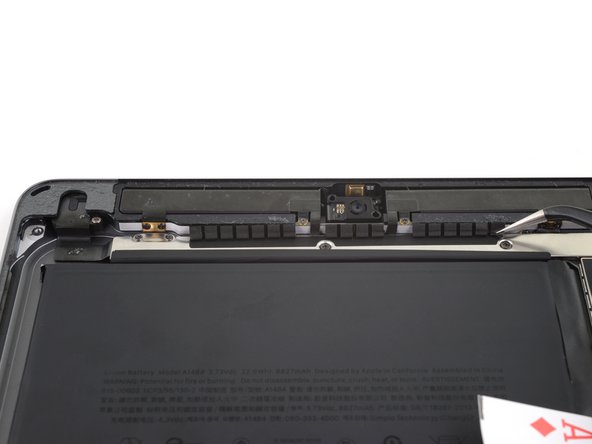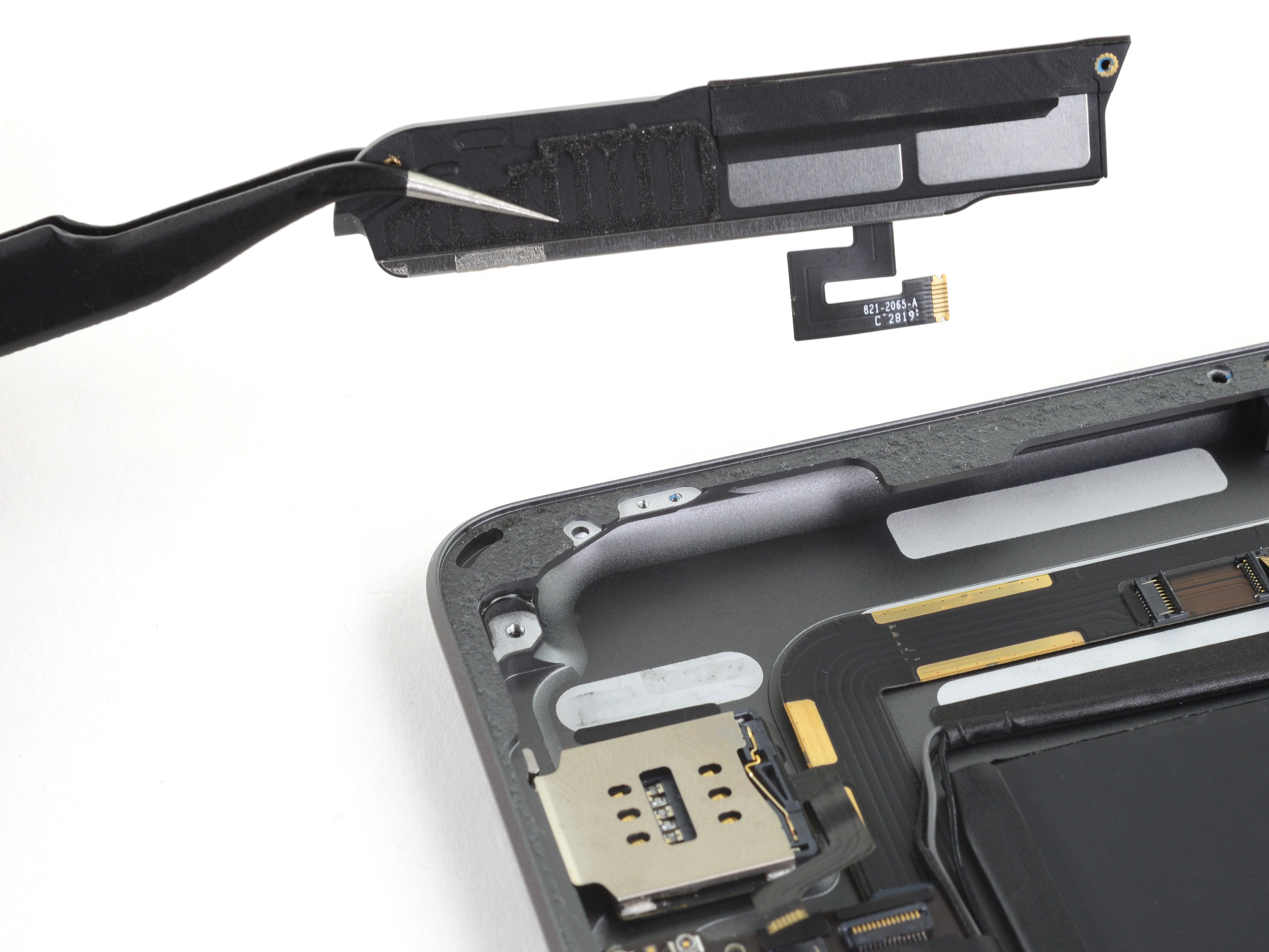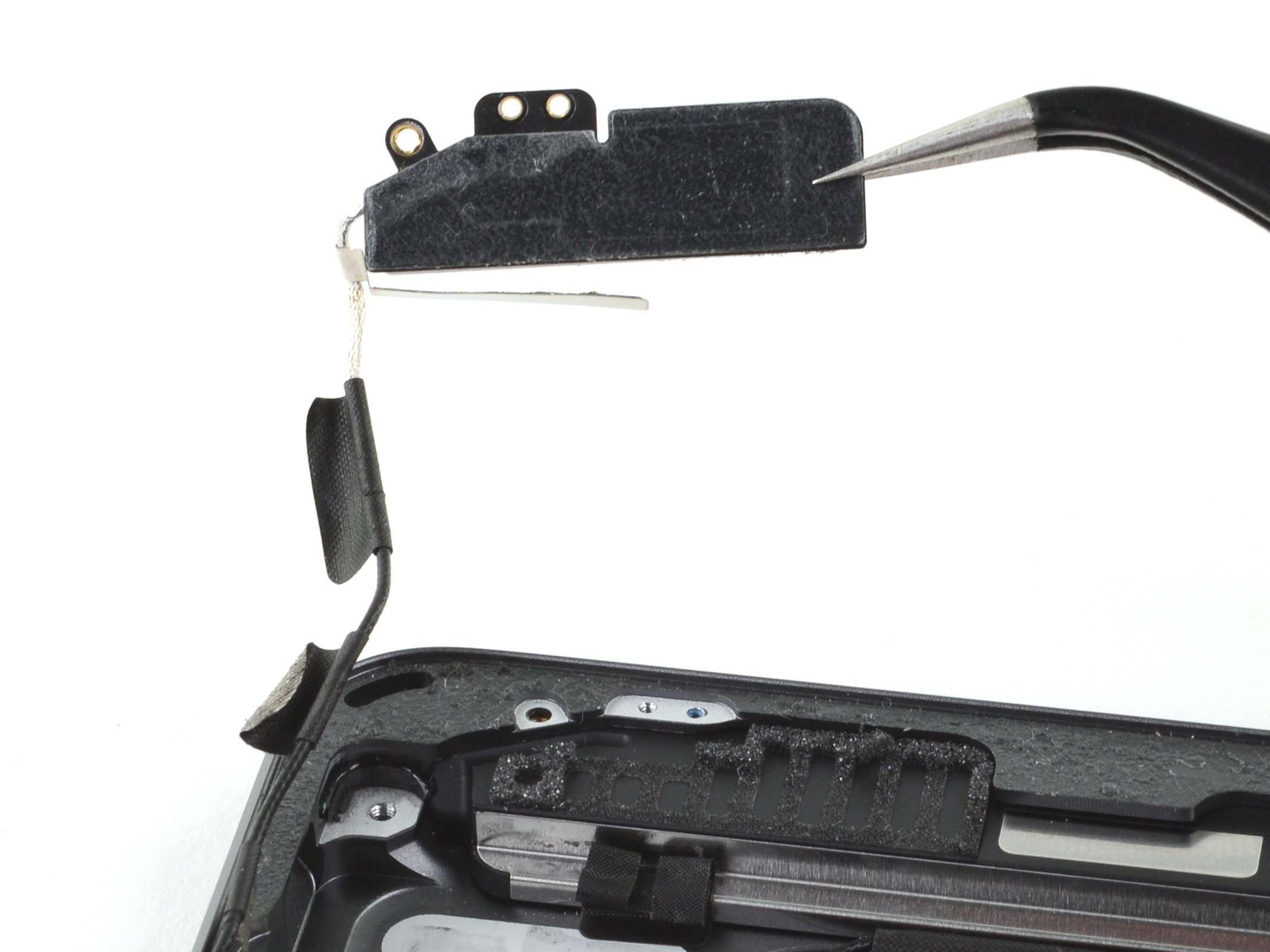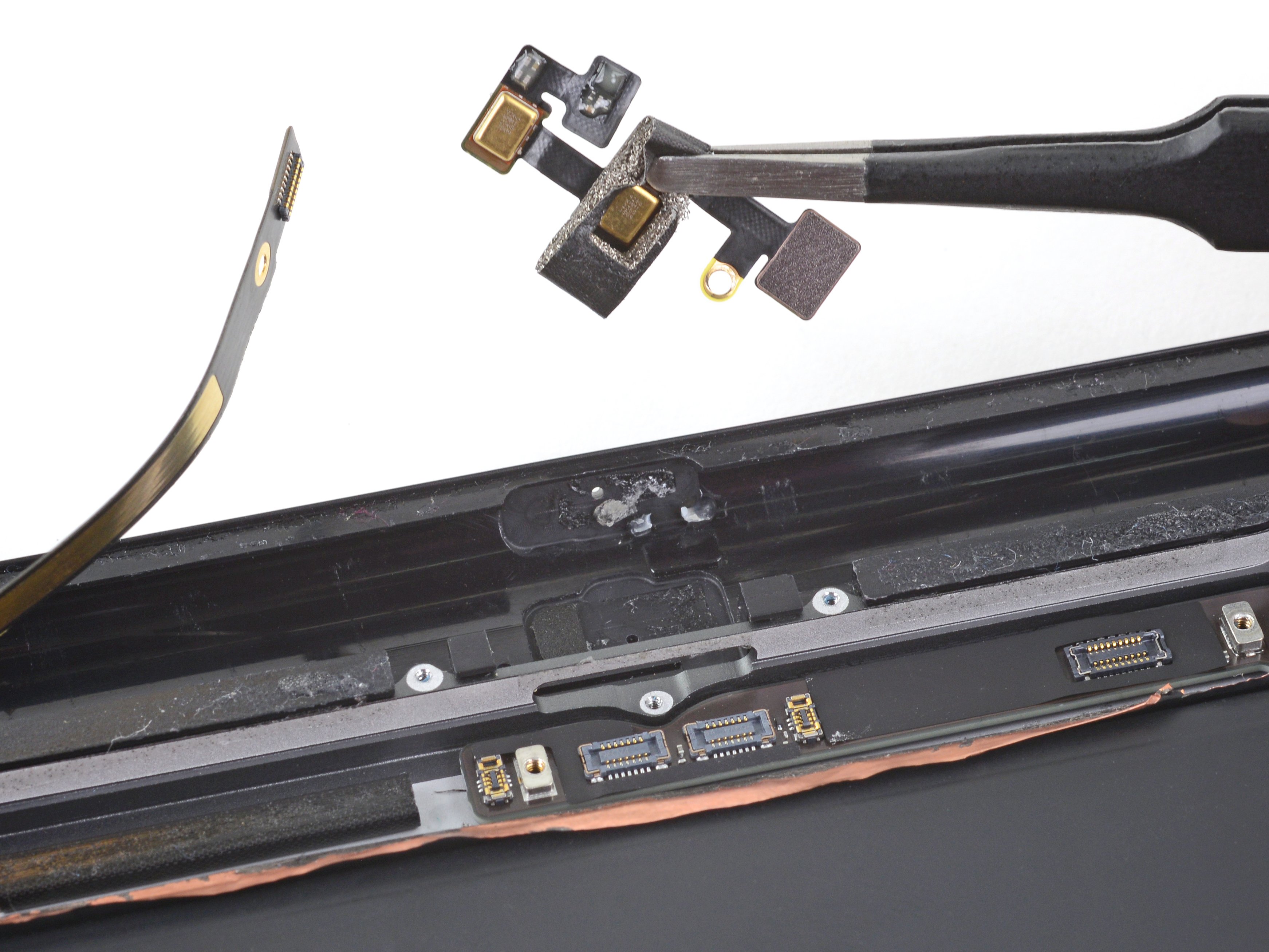iPad 7 Rear Camera Replacement
Duration: 45 minutes
Steps: 50 Steps
Use this step-by-step guide to remove or replace the rear camera on an iPad 7 LTE model. Heads up: this is for the LTE version only—if you have the Wi-Fi model, check the alternate guide. When disconnecting the battery with a battery blocker, handle it with care since those battery contacts are super fragile and can cause permanent damage if messed up. If you decide to skip isolating the battery, stick to non-metal tools whenever possible, only breaking out metal ones for screws to avoid short circuits and harming delicate components. Some pictures might be from a different model and look a bit different, but don’t worry—they won’t throw off the repair steps.
Step 1
- Warm up an iOpener and stick it on the left side of your device for a solid two minutes to loosen things up.
Tools Used
Step 2
- As the adhesive starts to soften, keep an eye out for these tricky spots that don’t like being poked:
- Front camera
- Antennas
- Display cables
Step 3
These next three steps walk you through using the Anti-Clamp, our handy little helper that makes popping open your device a breeze. Not using it? No worries—just skip ahead three steps for another way to do it.
Need the full scoop on using the Anti-Clamp? Check out this guide for all the details.
If your iPad is feeling extra slippery and the Anti-Clamp keeps sliding, slap on some tape to give it a better grip and keep things steady.
- Slide the blue handle back to free the Anti-Clamp's arms—think of it like opening a tiny trapdoor!
- Prop up your iPad on a stable surface so it sits nice and level between the suction cups.
- Place the suction cups along the left edge, one near the top and the other near the bottom—right in the sweet spot.
- Keep the bottom of the Anti-Clamp steady and give the top cup a firm press to get a solid grip.
Step 4
- Grab the blue handle and pull it forward to lock those arms in place.
- Give the handle a full 360-degree clockwise twist, or keep turning until the suction cups start to stretch a bit.
- Keep an eye on the suction cups to make sure they stay lined up. If they start to wander off, just loosen them a tad and realign the arms.
Step 5
Take it slow, turn no more than half a twist at a time, and give it a minute to breathe between each turn. Let the Anti-Clamp and time work their magic for you.
Looking for the full scoop on how to handle a hair dryer? Check out this guide.
If the Anti-Clamp isn’t making enough space, give the area a little more heat and twist the handle clockwise about half a turn.
- Hold tight for about a minute to let the adhesive chill out and create a little gap.
- If your screen feels more like a chilly breeze than a warm hug, try warming up the left edge of the iPad with a hair dryer.
- Slide an opening pick under the digitizer once that Anti-Clamp has made enough room to wiggle in.
- Go ahead and skip the next step.
Step 6
If your screen is sporting some serious cracks, don’t sweat it! Slapping on a layer of clear packing tape can help the suction cup stick like a pro. If you're feeling adventurous, some super strong tape might just do the trick instead of the suction cup. And if you're really in a bind, a little superglue on the suction cup and your broken screen could be your secret weapon!
- Once the screen feels nice and warm, grab your suction handle and place it as close to the left edge of the screen as you can.
- Gently pull on the suction handle to lift the screen just enough to create a tiny gap between the digitizer and the frame.
- Slip an opening pick into that little gap you've made, and you're good to go!
Tools Used
Step 7
No need to stress if you spot the opening pick peeking through the digitizer — just pull it out. The LCD screen should be fine, but be aware, you might leave behind some sticky adhesive that can be a little tricky to clean up.
- Pop in a second opening pick right where you made that first gap.
- Gently slide that pick over to the bottom-left corner of the device to break free the adhesive.
- Keep the pick nestled in the bottom-left corner to keep that adhesive from getting cozy again.
Step 8
- If the opening pick gets stuck in the adhesive, gently roll it along the side of the iPad to keep separating the adhesive. It's like a little dance—smooth and steady.
Step 9
- Gently slide your first opening pick up towards the top-left corner to loosen that stubborn adhesive.
- Keep the pick wedged in the top-left corner to stop the adhesive from snapping back together.
Step 10
- Warm up your iOpener and give it a cozy two-minute hug on the top edge of your device.
Tools Used
Step 11
- Gently twist the pick around the top-left corner to loosen that stubborn adhesive.
Step 12
Keep the pick away from the front camera lens while sliding to avoid any oops moments. The next steps will guide you on how to dodge that lens and keep it safe.
- Carefully slide the opening pick along the top edge of your device, making sure to stop just shy of the front camera. Precision is key!
Step 13
- Gently tug on the pick until just the tip is nestled between the digitizer and the frame.
- Slide that pick above the front camera to break free the adhesive.
- Keep the pick close to the right side of the front camera before moving on.
Step 14
- Slip the pick back in and slide it toward the top-right corner to fully break through the top adhesive layer.
- Keep the pick wedged in that corner so the adhesive doesn’t sneak back together.
Step 15
- Warm up that iOpener and give it a cozy hug on the right edge of your device for a solid two minutes.
Tools Used
Step 16
- Gently twist the pick around the top-right corner of the device to break the adhesive seal. Take it slow and steady—this step doesn’t need to be rushed.
Step 17
The display cables hang out about halfway up from the bottom of your iPad. Give a gentle slide until you hit three inches from the bottom—then stop right there!
- Grab a fresh opening pick and gently slide it halfway along the right edge of your iPad.
Step 18
- Warm up an iOpener and place it on the bottom edge of the device for about two minutes. Let the heat work its magic and soften things up before you move on.
Tools Used
Step 19
Be careful not to twist the pick too much around the corner; it could cause some antenna trouble.
- Slide the bottom-left pick into the corner and gently lift to break the adhesive seal.
- Once you've got the pick in place, leave it there before moving on to the next step.
Step 20
Slide the pick gently towards the home button, but avoid pushing it the other way—you don't want to accidentally mess with the antenna. Stay cool and careful!
If you find yourself needing to glide the pick over this spot again, just take it out and pop it back in at the bottom-left corner. Easy peasy!
- Pop a fresh opening pick into that little gap you just made at the bottom of the iPad.
- Gently glide the pick over the antenna, but stop just shy of the home button.
- Keep the pick to the left of the home button as you carry on with your repair journey.
Step 21
Just gently slide the pick up to about 1mm to keep the right antenna safe and sound. No need to push it any further!
- Slide an opening pick into that gap you've just made. You're on the right track!
- Gently ease the pick underneath the home button, heading toward the bottom-right corner. Just get the tip between the digitizer and the frame – you don't need to go deep, just enough to make it work.
Step 22
Slide the pick gently only toward the home button—going the other way might mess with the antenna, and we want to keep things safe and sound!
If you need to glide the pick over this part again, just pull it out and pop it back in at the bottom-right corner. Easy peasy!
- Slide that pick back in and glide it toward the home button to fully loosen the bottom adhesive.
- Set the pick just to the right of the home button and get ready for the next step.
Step 23
- Warm up an iOpener and stick it on the right edge of your device for two minutes to loosen things up.
Tools Used
Step 24
Take it slow with this one! Make sure the adhesive is nice and warm, soft enough to work with, and use your pick to gently separate it. If you need to, don’t hesitate to stop and reheat—better safe than sorry!
If you're feeling some serious resistance, don't sweat it! Just reheat those edges and gently work your trusty opening pick along them. You've got this!
- Gently twist the two opening picks at the left corners of the iPad to pry up the digitizer just a bit, breaking the last bits of adhesive holding it down.
Step 25
- Gently lift the left edge of the digitizer upwards to loosen the adhesive along the right edge of the iPad a bit more.
Step 26
- While keeping the digitizer steady, gently slide an opening pick between the two display cables to break the last of the adhesive. Take your time here—patience is key!
Step 27
- Once you've peeled away all that pesky adhesive, gently open the digitizer like a book and lay it down parallel to the iPad. It's like giving it a little hug!
- When putting everything back together, don’t forget to wipe away any leftover adhesive from the frame—and the digitizer if you're reusing it—with some isopropyl alcohol. To keep things snug, swap in our adhesive strips or those handy pre-cut adhesive cards.
- As you reassemble your device, keep an eye on those display cables. Tuck them away neatly underneath the LCD screen to ensure they stay safe and sound.
Step 28
- Grab a Phillips screwdriver and unscrew the four 4.3 mm-long screws holding that LCD in place. They’re not going to escape, so don't worry!
- As you work through this, keep track of every screw. Think of them as your trusty sidekicks, and make sure each one goes back exactly where it came from. You don’t want any loose ends messing with your device.
- Peel back any tape hiding the LCD screws. It’s like unwrapping a present, but without the confetti.
Step 29
Hold up! Don't yank the LCD out just yet – it's still hanging on by a few cables near the home button.
Gently lift the LCD starting from the front-facing camera side only.
- Gently use the flat end of a spudger to nudge the LCD out of its snug spot just enough so you can grab it with your fingers.
- Now, flip that iPad LCD like you're turning the page of a thrilling book, lifting it near the camera and flipping it over towards the home button side of the rear case.
- Carefully place the LCD down on a clean, soft, lint-free surface, giving yourself plenty of room to work with those display cables.
Tools Used
Step 30
- Grab your trusty Phillips screwdriver and carefully unscrew that lonely 2.3 mm-long screw holding the battery connector snug against the logic board. You're doing great!
Step 31
Check out these pics to see what the battery connector looks like tucked under the logic board. Keep them handy as you carefully disconnect the battery.
Heads up: the battery connector has cantilever springs on the logic board that press against the battery pads. Since both the logic board and battery are glued down, you'll want to gently slide a thin, flexible tool between the contact points to pop the battery loose.
Step 32
Handle the battery blocker with care! Those battery contacts are delicate and can bend or snap easily, leading to damage you won’t be able to fix.
Make sure the iFixit logo on the battery blocker is facing upwards, just like a superhero ready to save the day!
Be gentle with the battery blocker! No need to shove it under the connector with all your might. If it’s playing hard to get, grab a playing card to help disconnect the battery instead.
The battery blocker or playing card should glide smoothly under the logic board without any hiccups. Once in, it should sit at about a 15-degree angle, looking cool and collected.
- Gently slide that battery blocker under the logic board's battery connector at a cool 35-degree angle. You've got this!
- Keep the battery blocker snugly in place while you work your magic. You're doing great!
Tools Used
Step 33
- Grab your Phillips screwdriver and carefully unscrew the three tiny 1.4 mm screws holding down the display cable bracket. Keep track of those little guys!
Step 34
- Take off the display cable bracket with care.
Step 35
- Gently use the flat end of a spudger to lift the LCD cable’s press connector straight up and disconnect it.
- When reconnecting press connectors like this, carefully line up one side and press down until you hear a click, then do the same on the other side. Avoid pressing the middle — a misaligned connector could bend the pins and cause permanent damage.
Tools Used
Step 36
- Carefully take the LCD off completely and lay it face down on a clean, soft, lint-free surface to keep it safe and sound.
Step 37
- Grab your trusty tweezers and gently lift the tape that’s hiding the home button cable’s ZIF connector.
Tools Used
Step 38
- Gently use the tip of a spudger, an opening tool, or even your fingernail to lift up the tiny, hinged locking flap on the home button cable ZIF connector. Easy does it!
Tools Used
Step 39
- Grab your trusty tweezers and gently wiggle the home button ribbon cable straight out of the ZIF connector like a pro.
Tools Used
Step 40
Be gentle and pry only on the connectors themselves—avoid poking the socket on the logic board to keep your iPad safe and sound.
- Grab that trusty spudger and use its flat end to gently lift the two digitizer cables right up off the press connectors. You've got this!
Tools Used
Step 41
Heads up! Be gentle and avoid poking or ripping the home button ribbon cable—it’s delicate!
- Grab the flat end of your spudger and gently lift up the vibration isolator beneath the SIM card reader.
- Now, just take out the vibration isolator and set it aside.
Tools Used
Step 42
The cable is held in place with a bit of light adhesive.
- Grab your trusty tweezers and gently lift the home button cable away from the rear case like a pro.
Tools Used
Step 43
Grab an opening pick and gently slice through any leftover sticky glue still holding the front panel assembly to the frame.
Keep in mind, without the right insulation, parts of the digitizer might short-circuit against other components, messing up your touch screen.
This insulation is sneaky—it’s invisible to the naked eye and not the same as the foam dust barriers you see on many iPads.
- Take off the front panel assembly carefully.
- If your new display starts acting up with weird "ghost" or "phantom" touches, no worries! Just add a super thin layer of insulating tape like Kapton (polyimide) tape to the highlighted spots on the back of the panel. Replacement digitizers usually come with this insulation built-in, so you probably won’t need extra tape.
- When putting everything back together, make sure to scrape off any leftover adhesive from the iPad. Then, clean the sticky areas really well using high concentration isopropyl alcohol (90% or more) and a lint-free cloth. This gets the surface ready for new adhesive and helps it stick like a champ.
- Before sealing it back up, test your iPad’s functions and apply the pre-cut adhesive strips to the back of the display following our display adhesive application guide.
Step 44
- Gently lift the LCD buffer tape off the top component bracket, taking your time to avoid any unnecessary tugging.
Step 45
- Grab a Phillips screwdriver and unscrew the five screws holding the top component bracket in place. You've got this!
- Remove the three screws, each 1.4 mm in length. Easy does it!
- Now, tackle the two 1.9 mm screws. A bit longer, but still smooth sailing!
Step 46
You might need to gently peel off the upper component bracket if it's being held in place by some tape on the logic board.
- Gently pry up the upper component bracket using the pointy end of a spudger until you can grab it with your fingers.
- Take off the upper component bracket.
Tools Used
Step 47
- Grab your trusty spudger and gently lift the rear camera connector straight up like you're giving it a little high-five. Disconnecting it is that simple!
Tools Used
Step 48
- Warm up your iOpener and gently press it against the rear camera for about thirty seconds. This will help loosen things up and make the next steps a breeze!
Tools Used
Step 49
- Grab your opening tool and gently pop the rear camera out of the back case like a pro!
Step 50
- Time to put it all back together—just follow the steps in reverse order, and you'll be good to go.
- Got some e-waste lying around? Make sure it gets recycled properly by heading to an R2 or e-Stewards certified recycler.
- Things not going as smoothly as expected? No worries! Try some basic troubleshooting or check out our iPad 7 Answers community for some extra tips.
-































































































































